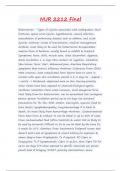NUR 2212 Final
Bioterrorism - Types of injuries associated with earthquakes: Skull
fractures, spinal cord injuries, hypothermia, wound infection,
exacerbation of pulmonary diseases such as asthma, and crush
injuries. Anthrax: routes of transmission, medical management
Anthrax: most likely to be used for bioterrorism Encapsulated,
inactive form of bacteria, usually found in wildlife & livestock
Symptoms: fever, chills, muscle ache, chest discomfort, dyspnea,
shock Incubation 1-6 days Skin contact, GI ingestion, inhalation
Skin lesions, fever, N&V, abdominal pain, diarrhea Respiratory
symptoms that mimics influenza •Anthrax: Cutaneous Form (Skin)
Most common, least complicated form Spores have to come in
contact with open skin Incubation period is 2-5 days Sx - papule -
> vesicle -> blackened, depressed area on skin Nursing priority
when clients have been exposed to chemical/biological agents.
•Anthrax: Inhalation Form Least common, most dangerous form
Most likely form for bioterrorism, can be aerosolized Not contagious
person-person Incubation period up to 60 days Use standard
precautions Sx: flu-like, SOB, stridor, meningitis, cyanosis (lead to
toxic shock), lymphadenopathy, lung hemorrhage If it leads to
death, it's most likely from hemorrhage •Anthrax : Gastrointestinal
Form Rare form & without Tx can be lethal in up to 50% of cases
From contaminated food (often livestock) & water Not as likely to
be used by terrorists Difficult to Dx & can be fatal by the time Dx
is made Sx: N/V, diarrhea, fever, bacteremia Foolproof screen test
doesn't exist Look at symptoms & recent history for exposure &
where they've been Prophylactic Tx if exposed: PO Cipro or
Doxycycline Tx if Symptomatic: Cipro IV q12hr, then Cipro PO for
up to 60 days S/S when exposed to specific chemicals (on power
point) Goal of triaging. START: priority interventions, know
, examples of which pts are tagged with different colors Green-
Minor Ex: ankle sprain Yellow- Delayed Ex: Open femur fracture
Red- Immediate Ex: Hypovolemic shock Black- Deceased or dying
Ex: Massive head injury Funeral arrangements for pts expired from
smallpox. Cremation Prioritization of pts into emergent, urgent,
non-urgent categories. Which patients are seen first? Emergent-
Urgent- Non-urgent- Questions to ask if bioterrorism is suspected.
Levels of PPE, examples. Goals of and the reason for
decontamination. Purpose: to shield the health care provider from
chemical, physical, biological, and radiological hazards that may
exist when caring for contaminated patients Categories of
protective equipment Level A: self-contained breathing apparatus
(SCBA) and vapor-tight chemical resistant suit, gloves, and boots
Level B: high level of respiratory protection (SCBA) but lesser skin
and eye protection; chemical-resistant suit Level C: air-purified
respirator, coverall with splash hood, chemical-resistant gloves and
boots Level D PPE consists of a surgical gown, mask, and gloves
Burn 3 - Superficial (1st Degree): Damage of the epidermis, pink,
mild edema, painful/ tender, sensitive to heat, heals in 3-6 days,
no scarring, sunburn and flash burn. Superficial Partial thickness
(2nd Degree): Damage to the entire epidermis and some parts of
the dermis, pink to red, blisters, mild to moderate edema, painful,
heals in 2-3 weeks, no scarring, but minor pigment changes, flash
flame, and scalds, brief contact with hot object. Deep Partial
thickness (3rd Degree): Damage to entire epidermis and deep into
the dermis, red to white, blisters are rare, moderate edema, eschar
soft to dry, painful and sensitive to touch, heals in 2-6 weeks,
scarring likely, possible grafting, flame and scalds, grease, tar, or
chemical burn, prolonged exposure to hot objects. Full thickness
(3rd Degree) and (4th Degree): Damage to entire epidermis and
dermis, can extend to the subcutaneous tissue, nerve damage, red,
black brown yellow, or white, no blisters, severe edema, eschar




